In love with Mayon
Legazpi City -- The Mayon and I have had a love affair for years. It started when I was a little kid. I saw a photo in one of our school textbooks of a farmer taking shelter from the rain, under a coconut tree, with the Mayon volcano in the background. The image of the mountain, a near perfect inverted cone, captured my imagination. I promised myself that one day, I would see it in person.
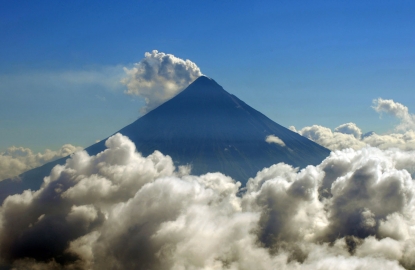 Mayon in May, 2010.
(AFP / Ted Aljibe)
Mayon in May, 2010.
(AFP / Ted Aljibe)I got my first chance as a student in Manila. I would take a bus home during semester breaks and saw it in the distance. It was so majestic, rising up surrounded by a sea of green, with that perfect cone pointing to the heavens. Gazing at it in the distance, it was hard to believe that such beauty could cause destruction and death.
I first got to see the effects of its power ten years into my photojournalism career. It was 1994 and Mayon erupted without warning, killing some farmers who were working at the foot of the mountain. We went there a few days later, but the mountain had calmed. We spent a few days in the area, waiting to another eruption that never came.
I was mesmerized by it. The weather was beautiful, so it was all blue sky and that cone. Green all around, except for the parts that were burnt by the erupting lava. Mayon is a bit peculiar in that its crater doesn’t collapse when it erupts. It may collapse a bit, but in between eruptions it heals itself. So the mountain retains this perfect shape.
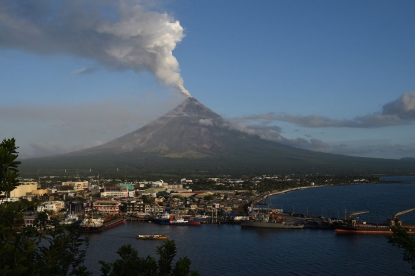 Mayon in January, 2018.
(AFP / Ted Aljibe)
Mayon in January, 2018.
(AFP / Ted Aljibe)I came back for eruptions in 2009 and again this year. Mayon is not a deep sleeper.
This year was marked by particularly prolonged activity. My bureau chief sent a photo and video team to cover it on January 24, two days into a worsening situation. We drove 10 hours to Guinobatan, one of the towns at the foot of the mountain that always seem to bear the brunt of the volcano’s fury.
We shot there for a few hours and then headed to Legazpi, a city nearby. As we drove, I saw a huge smoke column rising up above the cloud-shrouded crater. Mayon was welcoming us with a bang! The car screeched to a halt, we jumped out and started shooting. Some locals were nearby, some wearing face masks, others muttering to themselves, “Ash fall again.”
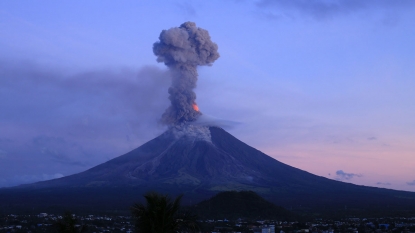 Mayon spewing a column of ash, January 24, 2018.
(AFP / Charism Sayat)
Mayon spewing a column of ash, January 24, 2018.
(AFP / Charism Sayat)We arrived at our Legazpi hotel near dusk, checked in and swiftly headed for Lignon Hill, a knoll beside the towering mountain where government volcanologists had set up an observatory. As darkness fell, Mayon started to emit lava and spew ash. Rocks cascaded the slopes of the volcano like a red river, an enthralling sight.
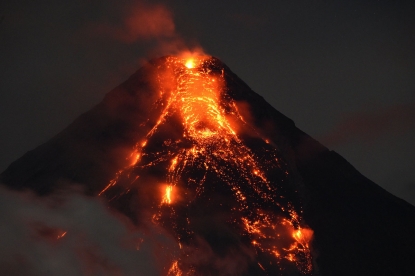 The Mayon volcano, January, 2018.
(AFP / Ted Aljibe)
The Mayon volcano, January, 2018.
(AFP / Ted Aljibe)Dozens of tourists were taking snapshots. Every time Mayon oozed lava, people would mutter and whistle in awe, like the sound a tree makes as its branches and leaves are being blown by the wind.
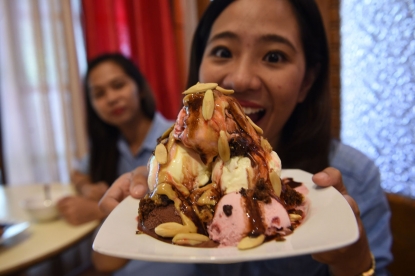 Residents show off chili-flavored 'lava ice cream' at a restaurant in Legazpi City, as Mayon erupts nearby on January 30, 2018.
(AFP / Ted Aljibe)
Residents show off chili-flavored 'lava ice cream' at a restaurant in Legazpi City, as Mayon erupts nearby on January 30, 2018.
(AFP / Ted Aljibe)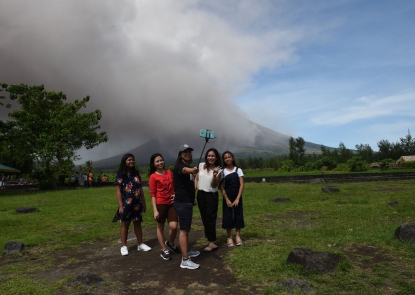 Taking selfies, with an erupting Mayon in the background on January 30, 2018.
(AFP / Ted Aljibe)
Taking selfies, with an erupting Mayon in the background on January 30, 2018.
(AFP / Ted Aljibe)
The next few days were spent driving around the farmlands around the volcano, looking for good spots to take photos. Then the rain began to pour. And pour some more. This continued until the next day, hiding Mayon in fog. I said to myself this is not good for the people, and me, because rain would mean "lahar", an Indonesian word that scientists use to refer to dangerous mudflows from the millions of tons of ash, rocks, and other volcanic debris being deposited by the eruption on its slopes and cascading down onto villages and homes destroying everything in its path. Luckily this time there was none.
Just prior to the downpour, I had visited farmland at the foot of the volcano. As I chatted with a farmer, two rainbows appeared. I looked at the farmer and was surprised that he seemed to be worried. He started telling me about local folklore. Each time a rainbow appears near Mayon, he said, it means the volcano will erupt. And this time there were two rainbows. Not a good sign. I nodded.
The next day, as Mayon spurted a column of ash into the air, I recalled what the farmer told me, looked up the sky, saw only a small column, and tried to convince myself: rainbows only color the skies.
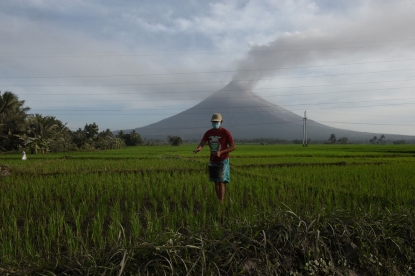 Farming as Mayon grumbles, January 30, 2018.
(AFP / Ted Aljibe)
Farming as Mayon grumbles, January 30, 2018.
(AFP / Ted Aljibe)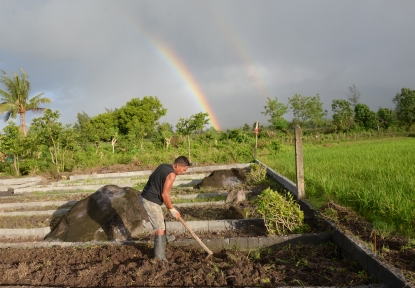 An ominous sign -- a double rainbow appears near Mayon as it erupts, January, 2018. According to local folklore, when a rainbow appears near Mayon, it means there will be an eruption. Luckily this time, a double rainbow meant just double the wonder in the sky. (Photo courtesy of Ted Adjibe)
An ominous sign -- a double rainbow appears near Mayon as it erupts, January, 2018. According to local folklore, when a rainbow appears near Mayon, it means there will be an eruption. Luckily this time, a double rainbow meant just double the wonder in the sky. (Photo courtesy of Ted Adjibe)
Covering Mayon would not be complete without getting the almost perfect shot, one taken near the foot of the volcano. One day, I and my colleagues, desperate for good pictures, ventured into a village leading up to the foot of the volcano, an area that had been deserted because of the eruption. We left the highway and went up a rough trail. After 30 minutes, we reached a dried-up river bed strewn with rocks and boulders thrown up by the volcano. I went up elevated ground and saw the foot of Mayon volcano. From where I stood, I could see the silhouette of a blackened mountain slope, with stumps of dead trees shorn of their leaves and branches.
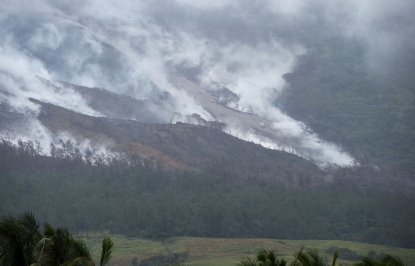 The view from the foot of Mayon on January 28, 2018.
(AFP / Ted Aljibe)
The view from the foot of Mayon on January 28, 2018.
(AFP / Ted Aljibe)I felt uncomfortable, remembering my horrifying experience of a 1991 eruption of another Philippine volcano, the Mount Pinatubo. I told myself this is close enough and hurriedly told my colleagues we should go. But as we retreated I was surprised to see many residents walking back to their homes. They were risking their lives to tend to their farms and livestock left behind in the hurried evacuations.
To me, this is what makes the Mayon so special. As far as volcanos go, it’s not too dangerous. It has the potential, of course, to cause havoc and death and destruction and sometimes, as during the 1994 eruption, it does on a large scale. But for the most part, its eruptions are safe enough to watch from a few kilometers away, like this year.
It’s like it’s there just for us -- she shows enough for us to take pictures, to be awed at nature’s beauty and power, but not to be hurt by it. It’s beautiful, powerful, but not too deadly. So you can enjoy it.
The next day, I climbed a hill at dawn to get a morning shot of the volcano. Getting to the right spot wasn't easy. Aside from climbing up a slippery and stone-filled pathway through thick vegetation, I had to carry with me 10 kilos of camera equipment. But I was rewarded when I reached the top. I gazed at Mayon, in a resplendent golden morning light and no clouds around. There it was again, as it has been in my life since I was a child. Magnificent and beautiful. Our love affairs continues.
This blog was written with Yana Dlugy in Paris.
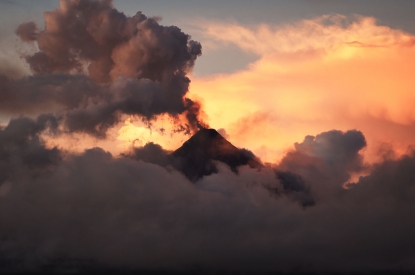 Mayon on January 26, 2018.
(AFP / Ted Aljibe)
Mayon on January 26, 2018.
(AFP / Ted Aljibe)




